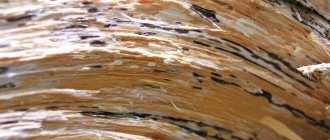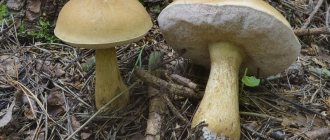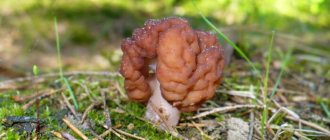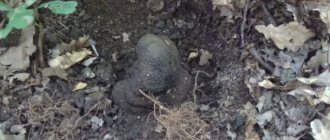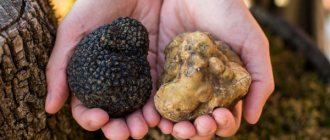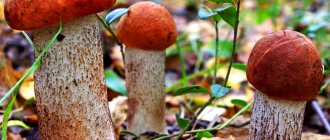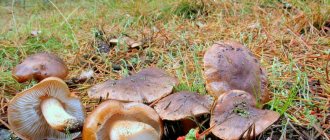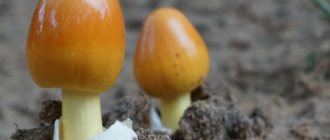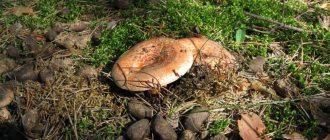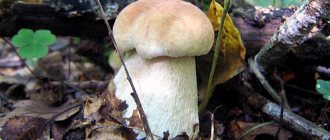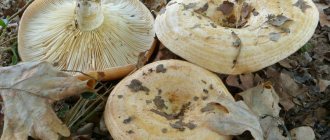The inner mass, first white, then yellow, olive and finally dark brown, ripens into spore powder; it is enclosed in a paper-thin inner shell that breaks at the top. When pressed, a cloud of spore powder emerges from the hole.
Season and place. Found from early spring to autumn on lawns and deciduous forests. Similarity. Reminiscent of some puffballs, but they are all edible. Do not confuse it with the common puffball! Grade. Edible while white.
What do blackened flutterbirds look like?
Blackening-type fluffy mushroom belongs to the 4th group of edibility. Before going into the forest, in order not to collect poisonous specimens, you need to study the external description.
The fruiting body of the forest “dweller” is spherical in shape, slightly flattened on the sides, no more than 6 cm in size. The surface is covered with a two-layer skin. The top layer of young representatives is snow-white; the skin is dry and velvety to the touch. With age, it acquires a coffee or cream color. In dry weather, the old skin cracks, and the inner shell, painted brown or black, can be seen with the naked eye.
The pulp is whitish, darkens with age. In autumn it degenerates, making room for dark spore powder. When the mushrooms are ready to reproduce, the skin ruptures, creating an opening for the release of spores.
Important! Fruiting lasts throughout the warm period.
Tincture of puffball mushroom for treatment
The puffball mushroom is used in the treatment of various diseases in the form of pre-prepared preparations. The most commonly used tincture of puffball mushroom is based on alcohol of varying concentrations.
For diseases of the lymphatic system (lymph nodes) and sarcoidosis - 1 teaspoon 2 times a day, course - until cure.
Infusion: 1 des. Pour a spoonful of mushroom spore powder into a glass of hot water (70°C) and leave under a lid in a porcelain or glass container for 40 minutes, take 1/2 cup 2 times a day before meals in small sips.
Tincture: prepared with vodka in a ratio of 1:5. Infuse the spores in a dark, warm place for 2 weeks. Take the tincture orally, 1-2 teaspoons 3-4 times a day before meals. The course is 3-4 weeks with a mandatory one-week break.
https://www.youtube.com/watch?v=ytdevru
To prevent the formation of stones in the kidneys and bladder, take bread sprinkled with raincoat spore powder orally.
For postpartum hemorrhage: leave 3 teaspoons of spore powder in 200 ml of boiling water for 2 hours, strain. Take 1 tbsp. spoon 3 times a day.
Rules for collection and procurement for medicinal purposes. Fully ripe mushrooms are collected to prepare spore powder or young fruiting bodies with completely white flesh.
Benefits and harm to the body
This specimen is not considered a valuable species, since it is inferior in chemical composition to milk mushrooms, saffron milk caps, chanterelles and boletus mushrooms. But the fruiting body includes a large number of macro- and microorganisms. Porkhovka blackens also contains quickly digestible carbohydrates, which are responsible for brain function and satisfying hunger.
Benefits of blackening fluff:
- increases hemoglobin;
- strengthens bone tissue;
- removes toxins and waste;
- strengthens the heart muscle;
- slows down cell aging;
- improves digestion.
Important! To improve the functioning of the body, it is necessary to consume this species in small quantities and only in boiled form.
Porkhovka also has contraindications. Mushroom dishes are not recommended:
- children under 5 years old;
- people with peptic ulcers and severe heart disease.
Since this species has poisonous specimens, the collection of fluff mushrooms should only be carried out by an experienced mushroom picker.
Beneficial features
Porkhovka is a very interesting and healthy mushroom, which may be inferior in taste, but nevertheless its benefits for the body are invaluable.
These wonderful mushrooms can absorb heavy metal salts with radionuclides accumulated in the body and remove them naturally, cleansing the body and preventing the development of cancer. In addition, mushrooms have a good tonic effect, improve the functioning of the immune system, and help in the fight against chronic fatigue, stress, and insomnia. They contain a huge amount of vitamins, amino acids and useful minerals, without which the human body simply cannot function normally.
False doubles
This forest “resident” has edible and inedible counterparts. These include:
- Lead-gray is an edible mushroom; only young representatives are used for food. It can be recognized by its small size. The fruit body is spherical in shape, up to 3 cm in diameter. The surface is covered with whitish skin, which turns dark gray with age. The pulp is dense and fleshy, without a pronounced aroma or taste. It prefers to grow in small families on sandy soil, along roads, in illuminated clearings, and in open forests. It begins to bear fruit from June to September.
- The common puffball is an inedible representative of the forest kingdom. It grows among deciduous and coniferous trees, begins to bear fruit in late autumn, and lasts until the first frost. The fruit body is round in shape, up to 6 cm in size. The skin is smooth, finely scaly, colored dirty lemon or brown. The pulp is dense, fleshy, white when young, gradually becoming purple-black.
Similar species
- Common false puffball.
Another double. It is distinguished by the yellowish color of the skin, its scaly surface, when, like a flutter, it is smooth. The pulp of the false hopeweed has a purple, blackish color, and the flesh smells like raw potatoes. This mushroom is inedible.
- Porchovka blackening.
Most often one can confuse it with the lead-gray fluff, from which it differs, in fact, only in the color of the inner shell, the endoperidium. The nutritional qualities of the blackened fluffwing are the same as those of the lead-gray species.
1-Common puffball. 2-Porchovka blackening.
Use
Only young specimens with tender, whitish flesh are used in cooking, as they have a delicate taste and a pleasant mushroom aroma. Before cooking, the harvested crop is thoroughly washed and cleared of hard skin. Then they can be dried, boiled, fried and canned. The aromatic, tender pulp is perfect for preparing hot salads, sauces, first courses and baking fillings.
Important! Since mushrooms are a heavy food, they should be given with caution to children and people with gastrointestinal diseases.
How can you make a photograph “breathe” and “come to life”?
The wizards of digital technology offered their own version of bringing photos to life: they combined a static photo with a short video of 1.5 - 3 seconds. This is when the smartphone camera, while taking a high-resolution photo, also captures video. As a result, with the help of clever overlays, you get a static photo with “elements” that come to life on it, this is when hair flutters, grass sways, water flows, etc. This creates a break in the perception pattern and the effect of magic: “The portrait smiled at me!”
One of the first live photos to become widely used was on iPhone smartphones, and this technology was called “Live Photos”.
HUAWEI and Honor smartphones also have a “live photo” function, when while photographing the device itself adds a 1.5-3 second video with sound. As a result, you immediately receive the finished product without resorting to additional processing.
But today you can only view live photos on the same HUAWEI smartphones using special applications, because In your phone's memory, a Live Photo consists of two files: a JPEG photo and a MOV video data file. Therefore, when viewing such a photo on other mobile devices, you will only see a static JPEG photo.
A very interesting effect is obtained when shooting in the genre of “portrait photography”, when in a “live photograph” the individuality of the hero suddenly appears in his characteristic movements of the head, his smile and bright eyes.
Particularly good are live photographs of dishes that literally come to life in the photo due to the rising steam over a cup of coffee or the dancing bubbles of champagne in a glass.
Facts[ | ]
| This section is an unordered list of various facts about the subject of the article. Please bring the information into an encyclopedic form and distribute it to the appropriate sections of the article. As decided by the Wikipedia Arbitration Committee, lists should preferably be based on secondary, aggregated authoritative sources that provide criteria for inclusion of items in the list. (4 May 2018) |
- In 2006, it was planned to rename the Prospekt Bolshevikov metro station to Okkervil.
- The Okkervil River flows in the Vesyoly settlement through the park named after. Yesenin, where walkers often have fun feeding a large number of ducks, many of which remain to spend the winter there.
- At the beginning of the 19th century, Okkervil was a navigable river.
- In addition to the officially named bridges, there are seven more small unnamed bridges across the river. They are located mainly inside residential areas; two of the bridges can be driven by vehicles, the other six are pedestrian.
- The song “Okkervil River” was performed by the group “Aquarium”.
- In 1985, Tatyana Tolstaya wrote the story “The Okkervil River.”
- In 1998, the indie folk group “Okkervil River” was formed in the US state of Texas.
